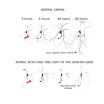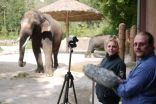(Press-News.org) (Santa Barbara, Calif.) –– Scientists have discovered that breaking a biological signaling system in an embryo allows them to change the destiny of a cell. The findings could lead to new ways of making replacement organs.
The discovery was made in the laboratory of Joel H. Rothman, a professor in the Department of Molecular, Cellular, and Developmental Biology at UC Santa Barbara. The studies were reported in the interdisciplinary journal Genes and Development, and were carried out by Ph.D student Nareg Djabrayan, in collaboration with Rothman and two other members of the laboratory, Ph.D student Erica Sommermann and postdoctoral fellow Nathaniel Dudley.
"At some point along the way toward becoming part of a complete individual, cells become destined to choose a particular identity and long-term profession," Rothman noted. "Once a cell chooses who it will be, it locks onto that identity for the remainder of its life."
A cell that is destined to become a heart cell functions exclusively in the heart until it dies, and never chooses later to change jobs by becoming, for example, a brain cell. "If Oz's wizard possessed the powers he claimed, and had a spare brain lying around, he could switch it to a heart as a gift for the Tin Man. And he could reverse the trick for the Scarecrow," Rothman said.
Similarly, the researchers have found a way to unlock cells' destinies and lead them to take on a new profession.
The scientists found that a widely used cell signaling system, known as "Notch" signaling, causes cells to commit to a particular occupation, such as a skin or brain cell. When they blocked the signal by genetic manipulation, the researchers discovered that they could force a cell to change its destiny, such that they instead became cells of the intestine.
"We found that we could break the signal in such a way that cells would follow their usual destinies, but were somehow less committed to doing so: We could convince them to change professions long after they would normally refuse to do so," Rothman said.
The scientists made the discovery by harnessing the genetics of a tiny nematode worm known as C. elegans, a model animal that has become famed in fundamental studies in biomedicine, and has been the subject of six Nobel prizes.
The researchers discovered that shutting off the Notch signal in early embryos made it possible for them to change the destiny of cells much later on, at a stage when they normally could not. "The later cells seemed to remember what had happened to their great-grandparent cells," Rothman said. "Imagine if the experience of your great-grandparents predestined you to become a lawyer, dentist, or coal miner, and you could not choose to change your professional destiny. That is what is happening to cells whose cellular ancestors received the Notch signal."
The research was supported by the National Institute of Child Health and Human Development and the California Institute of Regenerative Medicine.
The discovery could someday help scientists develop new ways to produce tissues and organs in the laboratory that could be used to replace a patient's injured, diseased, or aged organs. By unlocking a cell's normal destiny, it may be possible to change it into an altogether different type of cell that could be used to grow a new organ for a patient –– or perhaps, a Tin Man.
INFORMATION:
UC Santa Barbara scientists learn how to unlock the destiny of a cell: A gift for the tin man?
2012-11-01
ELSE PRESS RELEASES FROM THIS DATE:
How race and touchdown celebrations affect football player rewards
2012-11-01
The post-touchdown celebration is a familiar part of many football games. However, new research from the Kellogg School of Management at Northwestern University suggests that black players may be more likely than white players to be penalized for putting their feelings on display.
As a part of the study, Kellogg Ph.D. candidate Erika V. Hall and Professor Robert Livingston first analyzed all of the unsportsmanlike conduct penalties by NFL athletes during the entire 2010-2011 NFL season. Unsportsmanlike conduct includes the excessive celebration penalty. They found that ...
Cellular landscaping: Predicting how, and how fast, cells will change
2012-11-01
A research team at the National Institute of Standards and Technology (NIST) has developed a model* for making quantifiable predictions of how a group of cells will react and change in response to a given environment or stimulus—and how quickly. The NIST model, in principle, makes it possible to assign reliable numbers to the complex evolution of a population of cells, a critical capability for efficient biomanufacturing as well as for the safety of stem cell-based therapies, among other applications.
The behavior and fate of cells are only partially determined by their ...
New discovery shows promise in future speed of synthesizing high-demand nanomaterials
2012-11-01
NORMAN, Okla. – A new discovery by University of Oklahoma and North Carolina State University researchers shows a breakthrough in speeding up the process for synthesizing transition metal oxide nanostructures. What had once taken days can now be accomplished instantaneously.
After previous success using an oxygen-enriched flame to synthesize common nanomaterials, such as carbon nanotubes, nanofibers and fullerenes, OU College of Engineering professor Wilson Merchán-Merchán and his team conducted experiments using the same method to create a new form of nanostructures. ...
Study finds that adding soy to the diet does not affect onset of menopausal hot flashes
2012-11-01
(SACRAMENTO, Calif.) — A team of investigators led by UC Davis found that eating soy products such as soy milk and tofu did not prevent the onset of hot flashes and night sweats as women entered menopause.
Unlike previous studies investigating the relationship between soy and these menopausal symptoms, the current study included a very large population over a long period of time: more than 1,600 women over 10 years.
The article, titled "Phytoestrogen and Fiber Intakes in Relation to Incident Vasomotor Symptoms: Results from the Study of Women's Health Across the Nation," ...
Gene required for nerve regeneration identified
2012-11-01
A gene that is associated with regeneration of injured nerve cells has been identified by scientists at Penn State University and Duke University. The team, led by Melissa Rolls, an assistant professor of biochemistry and molecular biology at Penn State, has found that a mutation in a single gene can entirely shut down the process by which axons -- the parts of the nerve cell that are responsible for sending signals to other cells -- regrow themselves after being cut or damaged. "We are hopeful that this discovery will open the door to new research related to spinal-cord ...
A glimpse into neurosurgical risk prevention and the surgical checklist
2012-11-01
Charlottesville, VA (November 1, 2012). The November issue of Neurosurgical Focus is dedicated to lessening the number and severity of adverse events surrounding neurosurgical intervention for a variety of disorders. Guest editors Alexander Khalessi (University of California, San Diego), James Forrest Calland (University of Virginia), Gabriel Zada (University of Southern California), and Michael Y. Wang (University of Miami Health System) selected 16 articles on systems-based quality improvement for neurosurgical procedures.
The articles are divided into four major subtopics: ...
An elephant that speaks Korean
2012-11-01
An Asian elephant named Koshik can imitate human speech, speaking words in Korean that can be readily understood by those who know the language. The elephant accomplishes this in a most unusual way: he vocalizes with his trunk in his mouth.
The elephant's vocabulary consists of exactly five words, researchers report on November 1 in Current Biology, a Cell Press publication. Those include "annyong" ("hello"), "anja" ("sit down"), "aniya" ("no"), "nuo" ("lie down"), and "choah" ("good"). Ultimately, Koshik's language skills may provide important insights into the biology ...
JCI early table of contents for Nov. 1, 2012
2012-11-01
Congenital diarrheal disorder linked to a mutation in DGAT1
Congenital diarrheal disorders (CDD) are a group of rare intestinal diseases that are caused by genetic mutations. In a study published in the Journal of Clinical Investigation, Robert Farese and colleagues at the University of California, San Francisco, identified a family with two of three children affected by CDD. The affected children both carried a rare mutation in the DGAT1 gene. DGAT1 mediates the formation of triglycerides and is being assessed as a therapeutic target in the treatment of obesity. The study ...
Congenital diarrheal disorder linked to a mutation in DGAT1
2012-11-01
Congenital diarrheal disorders (CDD) are a group of rare intestinal diseases that are caused by genetic mutations. In a study published in the Journal of Clinical Investigation, Robert Farese and colleagues at the University of California, San Francisco, identified a family with two of three children affected by CDD. The affected children both carried a rare mutation in the DGAT1 gene. DGAT1 mediates the formation of triglycerides and is being assessed as a therapeutic target in the treatment of obesity. The study by Farese's group suggests that targeting of DGAT1 could ...
Feedback loop maintains basal cell population
2012-11-01
HOUSTON - (Nov. 2, 2012) – Notch – the protein that can help determine cell fate – maintains a stable population of basal cells in the prostate through a positive feedback loop system with another key protein – TGF beta (transforming growth factor beta), said Baylor College of Medicine researchers in the journal Cell Stem Cell.
"When basal cell homeostasis (or maintenance of a stable population) is disrupted, it may be part of the process that initiates prostate cancer," said Dr. Li Xin, assistant professor of molecular and cellular biology at BCM and a senior author ...


